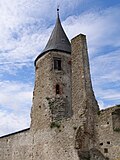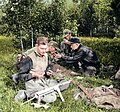Estonia Republic of Estonia , is a country by the Baltic Sea in Northern Europe . It is bordered to the north by the Gulf of Finland across from Finland , to the west by the sea across from Sweden , to the south by Latvia , and to the east by Lake Peipus and Russia . The territory of Estonia consists of the mainland , the larger islands of Saaremaa and Hiiumaa , and over 2,300 other islands and islets on the east coast of the Baltic Sea, covering a total area of 45,335 square kilometres (17,504 sq mi). Tallinn , the capital city , and Tartu are the two largest urban areas . The Estonian language is the official language and the first language of the majority of the population of 1.4 million.
Present-day Estonia has been inhabited by humans since at least 9,000 BCE. The medieval indigenous population of Estonia was one of the last pagan civilisations in Europe to adopt Christianity following the Northern Crusades in the 13th century. After centuries of successive rule by the Teutonic Order , Denmark , Sweden , and the Russian Empire , a distinct Estonian national identity began to reemerge in the mid-19th century. This culminated in the 1918 Estonian Declaration of Independence from the then-warring Russian and German empires. Democratic throughout most of the interwar period , Estonia declared neutrality at the outbreak of World War II , however the country was repeatedly contested, invaded, and occupied ; first by the Soviet Union in 1940 , then Nazi Germany in 1941, and ultimately reoccupied in 1944 by, and annexed into, the USSR as an administrative subunit (Estonian SSR ). Throughout the 1944–91 Soviet occupation, Estonia's de jure state continuity was preserved by diplomatic representatives and the government-in-exile . Following the 1988–90 bloodless Estonian "Singing Revolution " against Soviet rule, the nation's full independence was restored on 20 August 1991 . (Full article...
Haapsalu Castle (also
Haapsalu Episcopal Castle ,
Estonian :
Haapsalu piiskopilinnus ) is a
castle with
cathedral in
Haapsalu , western
Estonia . It was founded in the thirteenth century to be a center for
Bishopric of Ösel-Wiek . When there is a
full moon in the month of August, it is said that an image of a maiden, the White Lady, appears on the inner wall of the chapel.
In 1228, the Archbishop of Riga , Albert of Riga formed a new diocese consisting of Läänemaa , Saaremaa and Hiiumaa and designated Gottfried, an abbot of Dünamünde Cistercian monastery, as the bishop. The bishopric was created as a state of Holy Roman Empire on 1 October 1228, by Henry , King of the Romans . Papal legate Wilhelm of Modena fixed these borders permanently in 1234. The first residence of the Bishopric of Ösel-Wiek was located in Lihula Castle , where with the help of the Livonian Brothers of the Sword , a stronghold was built of stone. In an attempt to avoid conflicts with the influential Order, the Bishop transferred the diocese's residence to Perona , where it was burned by Lithuanians ten years later. A new center for the diocese was chosen in Haapsalu , where an Episcopal stronghold and cathedral were started. Building of the castle went on for three centuries.
Image 1 Tallink cruiseferries connect Estonia to neighboring Finland and Sweden (from
Estonia )
Image 2 Kadriorg Palace was built by
Peter the Great for his wife, Empress
Catherine I (from
Estonia )
Image 3 Bronze Age stone-cist graves in
Jõelähtme (from
Estonia )
Image 4 Passenger trains operated by
Elron connect the main cities in mainland Estonia (from
Estonia )
Image 5 The
barn swallow (
H. r. rustica ) is the national bird of Estonia. (from
Estonia )
Image 6 Administrative divisions of Estonia (from
Estonia )
Image 7 A half-loaf of fine rye bread. (from
Estonia )
Image 8 The
grey wolf is the national animal of Estonia. (from
Estonia )
Image 9 Estonian soldiers participating in
Constituent Assembly election in April 1919 (from
Estonia )
Image 10 Estonian
folk music performers dressed in 19th-century festive
folk costumes (from
Culture of Estonia )
Image 12 The seat of the Parliament of Estonia in
Toompea Castle (from
Estonia )
Image 13 Estonian volunteers in the
Finnish Infantry Regiment 200 during the
Battle of Vyborg Bay , July 1944 (from
Estonia )
Image 15 Policemen at a
Võidupüha parade in 2023 (from
Estonia )
Image 16 Rural Estonians began practicing democratic local governance in the 19th century.
Municipal elders of the
Viljandi County in the 1880s (from
Estonia )
Image 17 A traditional farmhouse built in the
Estonian vernacular style (from
Estonia )
Image 18 Wind farm in
Aseriaru (from
Estonia )
Image 19 A moment before the opening of the 25th
Estonian Song Festival (2009) at the Tallinn Song Festival grounds. (from
Culture of Estonia )
Image 20 Tallinn Bay during stormy weather (from
Estonia )
Image 21 Building of the
Supreme Court of Estonia in
Tartu (from
Estonia )
Image 22 In the
Baltic Way on 23 August 1989, two million people formed a human chain across three countries in a mass demonstration against the Soviet occupation. (from
Estonia )
Image 23 Põltsamaa Castle was the seat of
Magnus ,
King of Livonia from 1570 to 1578 (from
Estonia )
Image 24 Estonian underground miner conducts fieldworks to study oil shale reserves (from
Estonia )
Image 25 Satellite image of Estonia during spring (from
Estonia )
Image 26 Estonian farmers carefully harvest winter wheat with small machines at peak ripeness, balancing timing to ensure optimal grain quality (from
Estonia )
Image 27 Medieval Estonia and Livonia after the crusade (from
Estonia )
Image 28 LHV Pank is the largest financial enterprise based on Estonian capital (from
Estonia )
Image 29 The
University of Tartu is one of the oldest universities in Northern Europe and the highest-ranked university in Estonia (from
Estonia )
Image 30 Estonian farmers drinking (vodka) in an
inn , by
Oskar Hoffmann (painter) , 1899. (from
Culture of Estonia )
Image 32 Jaan Kross is the most translated Estonian writer. (from
Estonia )
Image 33 Ruhnu stave church, built in 1644, is the oldest surviving wooden building in Estonia (from
Estonia )
Image 34 Iron Age artefacts of a hoard from
Kumna (from
Estonia )
Image 35 Academia Gustaviana (now
University of Tartu ) was founded in 1632 by King
Gustavus Adolphus and was then the second university in the
Kingdom of Sweden . (from
Estonia )
Image 36 Narva Oil Plant employs advanced pyrolysis technology to convert raw organic matter into valuable products (from
Estonia )
Image 37 Product exports of Estonia in 2019 (from
Estonia )
Image 38 Jaanipäev (midsummer) celebrations are often held in communal areas with a
village swing (from
Estonia )
Image 39 The
Forest Brothers in 1953 (from
Estonia )
Image 40 Walls of
Varbola Stronghold , the largest fortress of Ancient Estonia (from
Estonia )
Image 41 Estonian soldiers during a NATO exercise in 2015 (from
Estonia )
Image 42 Kristjan Raud ,
Journey of Kalevipoeg to the North , 1935,
Estonian Art Museum (from
Estonia )
Image 43 Public education systems founded during prior Swedish rule made Estonia and Finland the two most literate areas of
Russian Empire (map of
1897 census literacy data) (from
Culture of Estonia )
Image 44 Population of Estonia 1960–2019. The changes are largely attributed to Soviet immigration and emigration. (from
Estonia )
Image 45 A
Russian Old Believer village with a church on
Piirissaar island (from
Estonia )
Image 46 Farm animals are an extremely common sight in Estonian countryside (from
Estonia )
Image 47 Siuru was an influential literary movement, founded in 1917 (from
Estonia )
Image 51 ESTCube-1 was the first Estonian satellite. (from
Estonia )
Image 52 Estonian Navy Kalev -class submarines in
Pärnu before the occupation of Estonia (from
Estonia )
Image 53 Independent counties of Ancient Estonia in the beginning of the 13th century (from
Estonia )
Image 54 Estonia has been one of
Ukraine 's most committed allies since the Russian invasions of
2014 and
2022 (from
Estonia )
Image 55 Georg Lurich trained
George Hackenschmidt and
Aleksander Aberg , all three being legendary wrestlers of the early 20th century (from
Estonia )
Image 56 Oven-grilled pork (
seapraad ) with
carrot slices. (from
Estonia )
Image 57 Corded Ware pottery and axes from around 2000 BC, at the
Estonian History Museum (from
Estonia )
Image 61 The cliff at
Valaste Falls illustrates the
stratigraphy of various geological eras (from
Estonia )
Select [►] to view subcategories
















































































